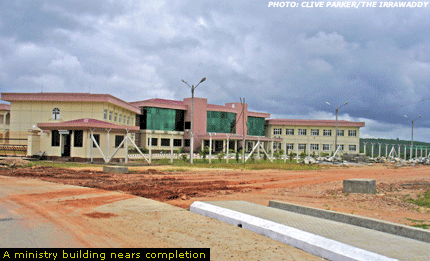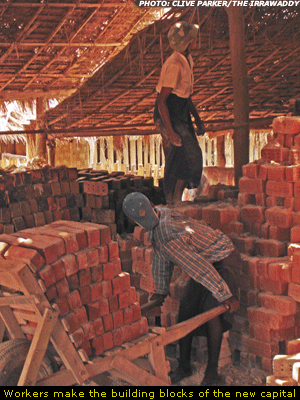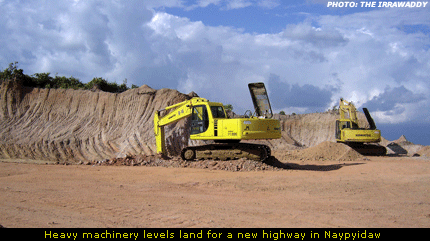
| By CLIVE PARKER | OCTOBER, 2006 - VOLUME 14 NO.10 |
In one of the first visits to Naypyidaw by a foreign journalist, The Irrawaddy’s Clive Parker discovers that building
Naypyidaw’s

Civil servants have worked for months in the only finished section—two furnished offices at the front of the building—while around them hundreds of sandal-clad workers carry bricks and lay cement. The din of sawing, banging and heavy machinery is constant.
After more than two years of construction, Asia World Company, the private Burmese contractor responsible for the building, says it will be a further 12 months before the project is completed, locals say, despite pressure from the authorities to finish by the end of 2006. Each week that passes costs the state millions of kyat in labor costs that it cannot afford.
Asia World is the country’s biggest construction enterprise, run by Tun Myint Naing, also known as Steven Law, barred from entering the
Nearly a year since the ruling State Peace and Development Council first began moving civil servants to its new administrative center,
However, since early 2004, when a European diplomat who happened to be traveling in Pyinmana noticed heavy machinery “bulldozing the ground,” there has been remarkable progress. Workers are putting the finishing touches on ministry buildings. Many still look rough around the edges, but outside others shrubs and flowers are being planted.
Homes for middle-ranking officials are also ready, although pathways and roads are still only half finished. A 300-bed hospital was opened six months ago. Telephone lines and an electricity supply—said to be the best in the country—are in service.

Snr-Gen Than Shwe, the head of the SPDC, reportedly moved into his 4,000 square-meter residence to the east of the Rangoon-Mandalay highway in February suggesting that too is finished—workers said they are no longer permitted into the compound, which is built into a hillside, without written permission from a senior defense official. The restricted military zone, including a high school for the children of high-ranking officials, also appeared to be nearing completion.
Nevertheless, after two and a half years of construction, Naypyidaw still lacks the infrastructure required to support a community.
High-ranking officials have fared much better than the government rank-and-file, whose living accommodations consist at the moment of makeshift huts on the outskirts of the city, the son of one government employee complained. The construction of permanent housing for low-level civil servants forms part of the second phase of development and could take years to complete.
There are few places to buy anything in Naypyidaw—in fact, few places to do anything as a visitor. The only shops lie on the edge of the
One article in The New Light of Myanmar in August provided this rosy depiction of the dusty capital: “A long row of new departmental buildings…in Naypyidaw has become a majestic scene for anyone visiting the place,” the article declared. “It will not be wrong to say that service personnel have entered a new age.”
 In light of other capital relocations, the limited progress in Naypyidaw after more than two years of effort is unsurprising.
In light of other capital relocations, the limited progress in Naypyidaw after more than two years of effort is unsurprising.
Asia World Company has been contracted by the government for another six years, which means that Naypyidaw will remain under construction until at least 2012. And for the 80,000 workers enlisted to build the
The International Labour Organization received reports that at least 2,800 people from the surrounding area were forced to build camps for three army battalions and an air force battalion to secure Pyinmana ahead of construction. “In addition to labor, each village had to provide roofing and construction materials and transport for the project,” an ILO report from March 2005 said. The government has denied the allegations.
The ILO has not received any verifiable evidence of forced labor since then, and says it is reluctant to draw attention to labor complaints from Naypyidaw for fear that the government might punish complainants for “spreading false information,” as it has in numerous other cases. The government agreed to a moratorium on such prosecutions in July.
The lowest-paid laborers in Naypyidaw make 1,500 kyat (US $1.10) a day. Some have travelled from distant parts of
Many of these laborers are required to work seven days a week, from dawn until nightfall. on the main roads leading into Naypyidaw, they can be seen at all hours pressing partly-set tarmac into potholes by hand.
Reporting on such developments in Naypyidaw can be dangerous, as two Burmese photojournalists discovered in March. Each was sentenced to three years in jail for taking photographs—strictly forbidden since the relocation was announced.
The burden of a capital relocation on a country’s human resources is predictably heavy—perhaps more so under a military dictatorship—but the financial burden can also be staggering, says Ed Schatz, a political scientist from the
“First, tremendous financial resources must be available for the move. The costs are not simply those of construction—which are always considerable and rarely under-budget,” he says, adding that relocating civil servants, citizens, foreign embassies and companies makes a capital move all the more expensive.
Although the lack of transparency over the building of Naypyidaw makes any realistic cost estimate impossible, a look at other recent capital city moves offers some idea of the financial scope of such an undertaking. When
Even if all 80,000 construction workers in Naypyidaw were paid the minimum 1,500 kyat a day (and they are not), the total annual labor cost for the project would come to 43.8 billion kyat ($32.32 million).

Over eight years, the wage bill, considered a much smaller outlay than material costs, would balloon into the hundreds of millions of dollars—money that economists say
EIU data shows that by the end of the 2005-2006 fiscal year last March, the Central Bank’s claims on the government had escalated to more than 2.3 trillion kyat ($1.7 billion), up from 1.3 trillion kyat ($960 million) at the end of 2003.
As early as 1998,
In June 2004, shortly after construction began on Naypyidaw, the Export-Import bank of
In a statement in August designed to allay fears that
The CIA estimates that by the end of 2005,
Despite strong statistical evidence that the move to Naypyidaw is pushing
The relocation project has had some positive economic impact. Local companies have benefited from the influx of new business, notwithstanding their allegations of the government’s confiscation of land. New shops that offer mostly construction materials and furniture have sprung up in old Pyinmana, which is not subject to the strict building and trading regulations applied in Naypyidaw.
Big construction companies—Asia World Company, Htoo Trading, Eden Group, Max Myanmar and Shwe Thanlwin—have also seen significant revenues, but the government’s reported inability to pay for services has required companies to generate income from numerous concessions offered in the place of cash.
These companies were all given the opportunity to build hotels in Naypyidaw, while the government simultaneously prohibited smaller operations in old Pyinmana from accepting foreign guests, thereby denying them the ability to earn foreign currency.
Max Myanmar has made the most of government concessions. It’s Royal Kumudra hotel, located in Naypyidaw’s new guest accommodation zone along an unfinished stretch of two-lane highway, is the busiest of the city’s new hotels—and one of the most expensive, charging $144 per night for its top-tier executive villas.
The hotel often runs at full capacity—this was the case in August, as it hosted teams of smartly dressed Asian businesspeople in town for high-level meetings with ministry officials. In the absence of cash payments from the government for its building contracts, Max Myanmar earns handsome revenues from such market restrictions.
At the beginning of 2005, Max Myanmar was also awarded joint development of a 5,000-acre rubber plantation with the army in
Air Bagan, owned by Htoo Trading chief Tay Za, became the first private airline to offer service to Pyinmana’s
Whether
History is not on
In Naypyidaw, there may not be talk of a coup, but residents’ discontent is as evident as their confusion about why the move was necessary in the first place. The civil servants and laborers who toil each day in the dust and despair that shrouds the new capital give little or no importance to the government’s construction timetables or cost projections. Being uprooted from their families and homes by force is all that concerns them.
“The question of timing… is less important than the question of whether or not it [the shift to a new capital] is necessary at all,” political scientist Schatz points out. “The first question should be: Should Naypyidaw exist?”
Naypyidaw’s Capital Progress March 2005—An International Labour Organization report alleges the forced conscription of at least 2,800 villagers in Pyinmana used in the construction of army camps that will later provide security for the project. June 2005—Civil servants of five government ministries, including the Ministry of Information, receive the first official notice that they will have to move to Pyinmana. November 2005—At 6:37 a.m. on November 6, December 2005—Maj-Gen Khin Aung Myint of the Defense Ministry confirms that a new military administration—Naypyidaw Command—has been established.
February 2006—Burmese leader Snr-Gen Than Shwe moves to his new residence on the east side of the new capital, a sprawling structure reportedly built into a hillside. The city is dubbed Naypyidaw, meaning “royal city,” in March 2006—Armed Forces Day is held in Naypyidaw for the first time. More than 12,000 troops participate in the de facto inauguration of the new capital. Meanwhile, Air Bagan becomes the first private airline to fly to Naypyidaw. May 2006—Ibrahim Gambari, the UN under secretary-general for political affairs, becomes the first high-ranking representative of the world body to travel to Naypyidaw during a visit to August 2006— |